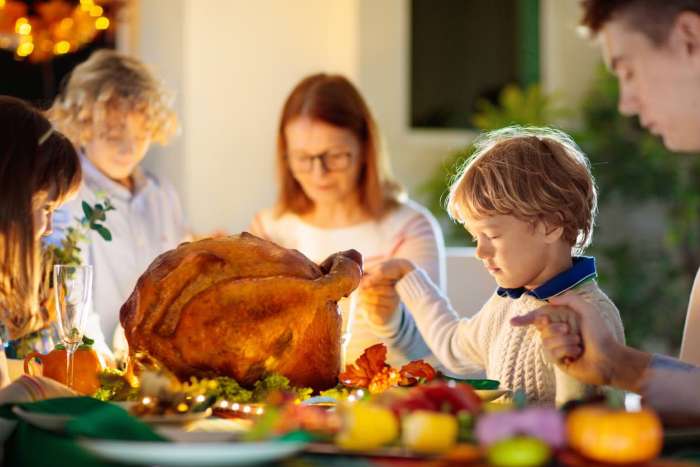My entire family loves Thanksgiving, and not just because of the feast that kicks off the holiday season. It’s a holiday for everyone, regardless of who they are or where they come from.
Thanksgiving is also the perfect time to start teaching your family about the true meaning of Thanksgiving for kids...and for all of us.
They can also learn about the benefits of gratitude.
Related: Giving Thanks at Thanksgiving, Charitable Ideas for Kids
What are the Benefits of Gratitude for Kids?

Expressing gratitude strengthens relationships with our loved ones. When you express gratitude, you let the people around you know that you value them. Grateful children are a treasure, and even young children can practice gratitude with siblings, parents, or other family members.
When you teach kids to be grateful, you also teach kids empathy by teaching them to think outside of their own experiences. They learn that good things don’t come to them out of the blue, but because of the actions of other people.
25 Fun Things to do on Father's Day
That special Sunday in June, Father’s Day, is a wonderful opportunity for older and younger kids to show dad how much they love him. Looking for simple and meaningful Father's Day activities that will help you bond with your dad? Check out these fun father-son and father-daughter activities for children of all ages and dads with all different interests. You're sure to make lasting memories! Read More
This, in turn, teaches them to appreciate others and do acts of kindness for people in their lives, or even strangers.
Gratitude is also good for our personal mental health and well-being.
A 2019 study by Frontiers that when subjects kept ‘gratitude lists,’ they were happier, had higher self-esteem, and were more satisfied with their lives.
It’s not hard to model gratitude and foster a sense of gratitude among the whole family. Here are some fun activities to get your family started.
1. Gratitude at the Dinner Table

Many people’s first experience with expressing gratitude is saying grace at the dinner table.
Even if your family isn’t religious, children can be taught from a young age to thank the person who prepared the meal, the person who bought the groceries, the people who grew the food, and so forth. And you don’t have to wait for the Thanksgiving holiday to start.
2. Keep a Gratitude Journal

A gratitude journal or a gratitude book is a fun way to keep track of the good things in your life, and to reflect on the people and circumstances who made them possible.
Review your “gratefuls” with your kids at the end of each week, and reflect on them.
3. Make a Gratitude Tree

Make a tree out of construction paper, or whatever paper you might have at hand, and hang it on the wall.
Your kids can help you to design and color it. Next, cut out some leaves. Every time someone thinks of something new to be grateful for, like a yummy meal or a nice sunny day, write it down and hang it up on the tree!
4. Surprise Someone with a Gratitude Jar

You can also write your “gratefuls” onto slips of paper and pop them into a jar to review and reflect on later.
For a unique gift idea, keep a gratitude jar for individual people. Surprise them for their birthday or Thanksgiving with a jar full of all of the ways that you’ve appreciated them that year.
5. Host a Thank You Notes Party

Thank you notes can be a chore, but nothing’s too onerous if you invite some friends to do it with you.
A thank you notes party gives everyone a chance to reflect on how others make our lives happier and richer. This can also be a great service project for a club or organization.
Try some of these:
- Thank you notes after a birthday or gift-giving holiday
- Letters of gratitude for health workers at your local hospital or clinic
- Notes for teachers, janitors, and support staff at your children’s school
- Notes of gratitude for armed forces members serving abroad
- Thank you notes to first responders in your area
- Thank you notes for workers at a restaurant, amusement park, or other place you’ve visited recently
6. Collect Food for a Food Bank

If your family has never known food insecurity, collecting food for a food bank can be a starting point for an important lesson in gratitude in daily life.
Start by contacting your local food bank to find out what they need. Make a list with your children.
You can take this time to discuss nutrition, food deserts, why junk food is cheaper than healthy food, and why it can be difficult for struggling families to get the nutritious food that they need.
Take up a collection in your neighborhood, and purchase some foods yourself. Then make sure to take your child along for the drop-off.
7. Help Out at a Homeless Shelter

Older children may enjoy helping the homeless by volunteering at a shelter. Some activities volunteers often do include:
- Packing hygiene kits to distribute to people in need
- Serving meals
- Reading to children in a shelter
- Collecting needed items or fundraising
8. Become a Pen Pal

During the pandemic, nursing home residents were among many people who suffered greatly from loneliness and social isolation. Becoming a pen pal for a senior can teach your child gratitude for their family and friends.
And as a bonus, getting involved in a pen pal program for kids can also be a great way for them to make new friends themselves!
9. Become a Nursing Home Visitor

Social isolation is terrible for both mental and physical health. Unfortunately, some nursing home residents live quite isolated lives. Your children can learn both gratitude and service by volunteering with nursing homes.
First, contact your local nursing homes to see what their needs are. Some may have age restrictions, as well. Next, determine whether you want your volunteering to be occasional or regular.
You can volunteer alongside your children or organize volunteering for a club or service group. Teens may enjoy volunteering on their own.
Here are some activities you might expect to do:
- Read to residents
- Become a regular visitor
- Play cards or board games
- Lead crafts
- Gardening or building maintenance
10. Raise Money for a Worthy Cause

Did you know that for every one dollar donated, a food bank can feed a family two whole meals?
You don’t have to raise a lot of money to do a lot of good. Here are some ways you and your kids can raise money for your favorite cause:
- Plan a sponsored walk or bike ride. Make it fun by wearing costumes.
- Organize a read-a-thon at your children’s school.
- Older kids could combine social media and online fundraising by putting together a viral video challenge.
The only limit is your family’s imagination!
Teach Kids Gratitude All Year Round
Teaching gratitude is good for your children and family. It also helps to make the world a better place.
Keep in mind that a lot of people volunteer during the holiday season. It’s natural. That’s when gratitude and giving are on a lot of people’s minds.
But need is year round, and your family’s help may be appreciated more during other times of the year.
So if you’re teaching gratitude through collecting, donating, fundraising, or volunteering, be sure to ask your target organization when they most need the help.
How does your family practice gratitude? See more of our ideas on teaching kids to be thankful and help others with these: 7 Books That Teach Kids Kindness and Good Manners.



